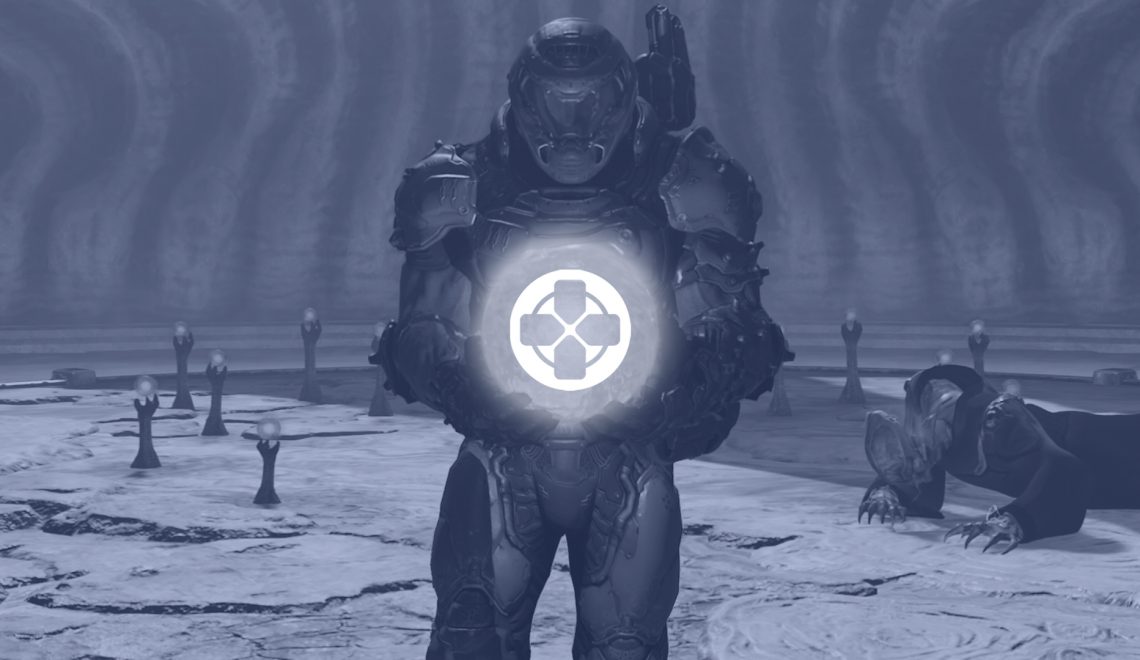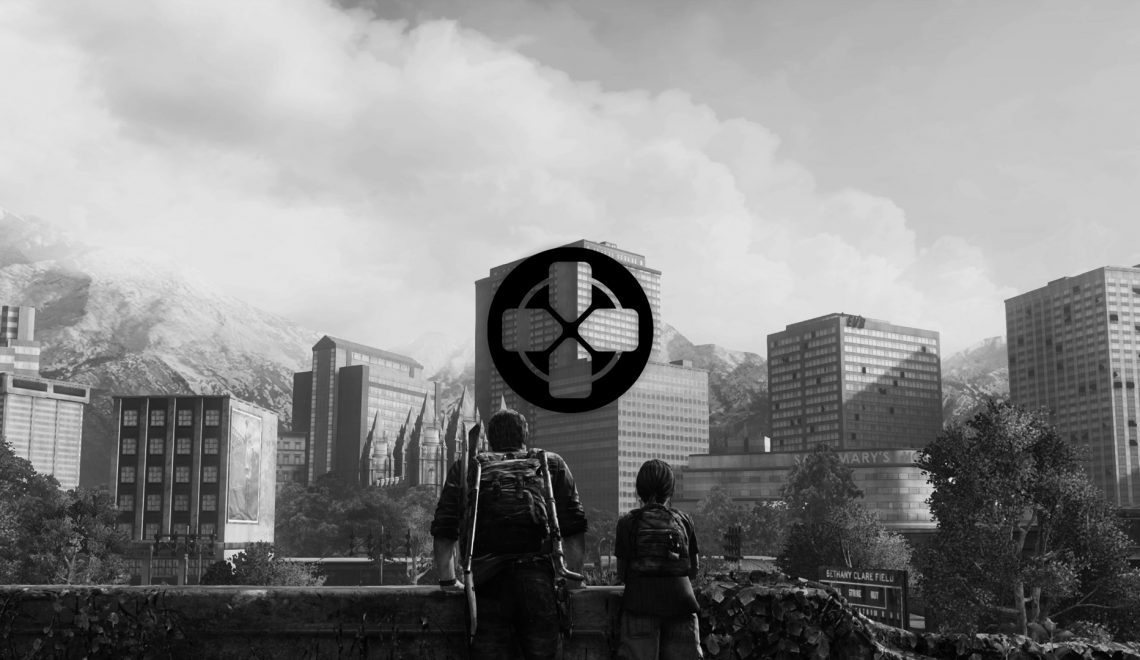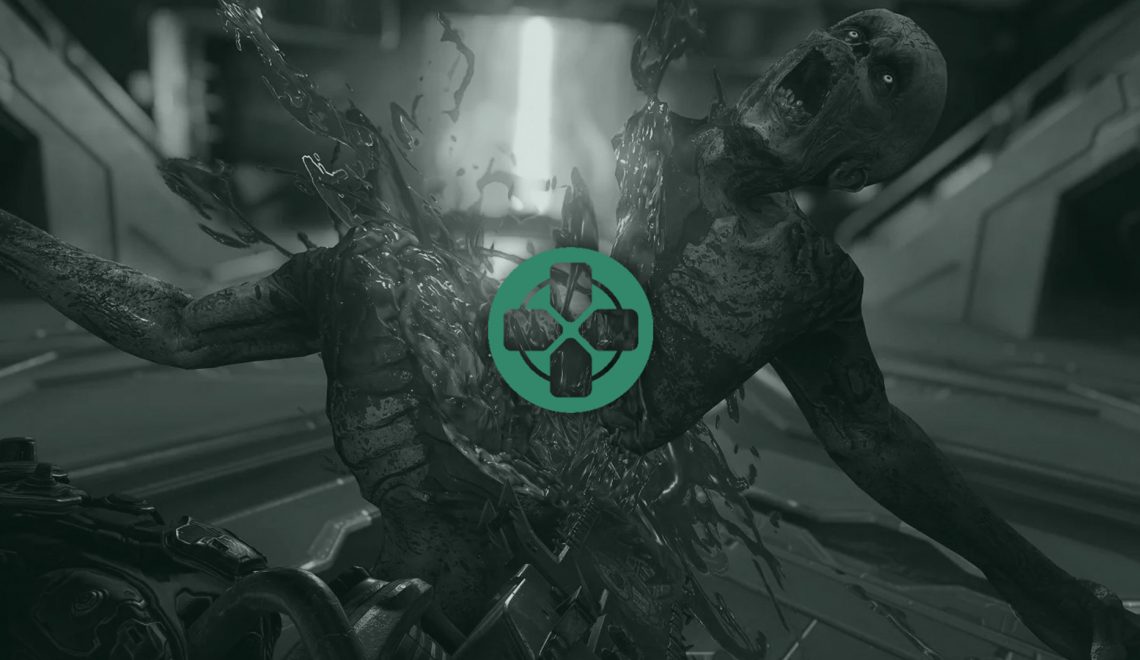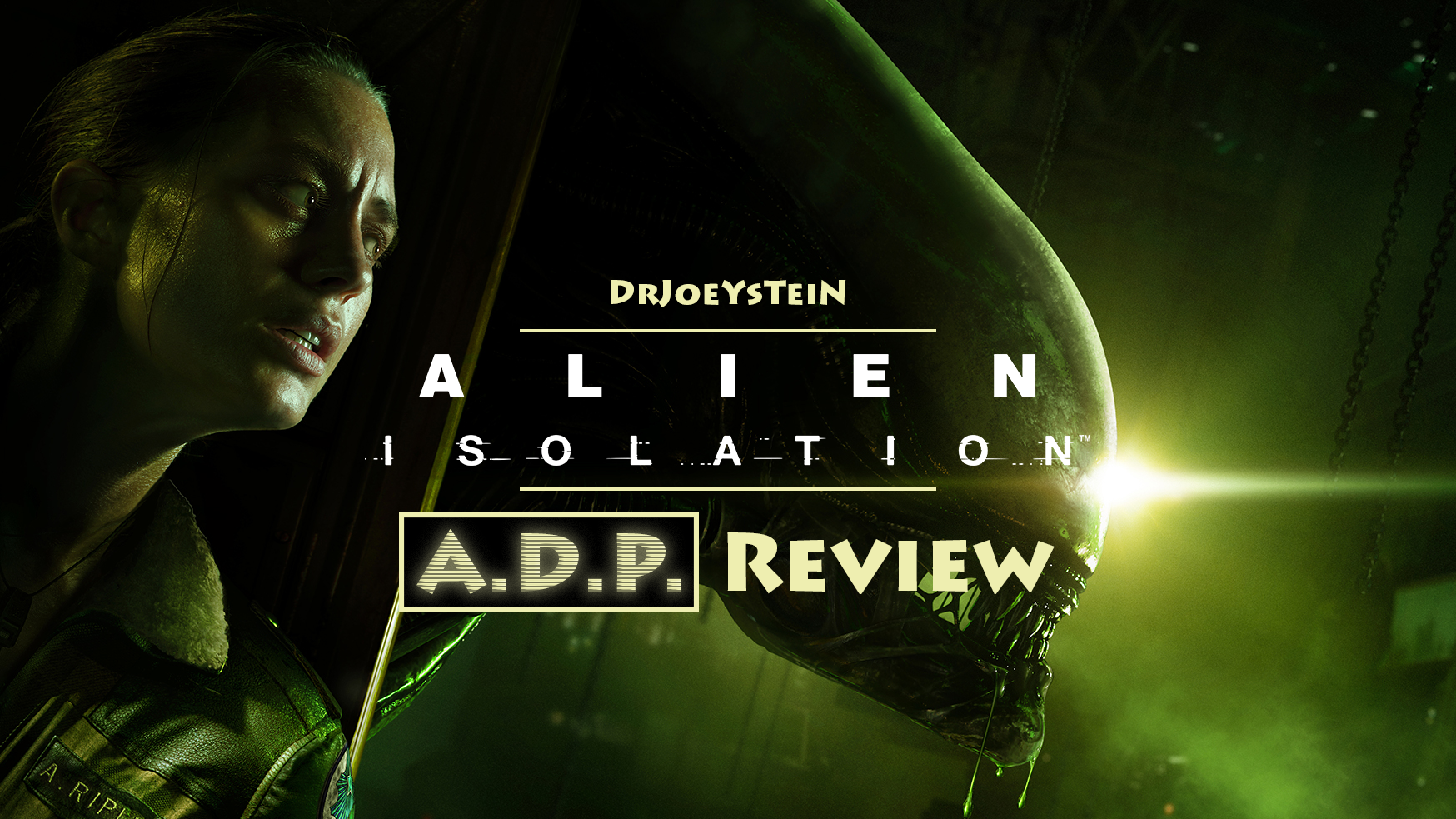
There’s a multitude of “must-see” movies that I haven’t watched yet. To Kill a Mockingbird, Predator, The Godfather, Back to the Future…my shameful list goes on and on until you’d realize I really haven’t set aside time for classics like these. Part of that comes from my free time being prioritized for video games, reading, and writing. Anything else on the TV or at the theater has to be pretty compelling to drag me away from my main hobbies, such as Mad Max: Fury Road, Star Wars: Rebels, Sword Art Online, or Alien. Ah, that movie. I saw it for the first time in October 2014 during the week of Halloween back-to-back with Aliens and one more time a few months later with some close friends. During that second go around though, I decided to subtly observe their faces to see how they’d react to a jump scare, a disturbing moment, or an awe-inducing scene. Would there be wonder in their eyes when they saw the unknown ship on LV-426? Fright when the Chestburster emerges out of Kane? Tension when Ripley finds out the Xenomorph is on board the escape ship with her? Scenes like these carry an objective power because they contain iconic moments and gorgeous cinematography set among retro-futuristic sets and props that are as memorable as what’s in Star Wars. All of it comes together to produce a movie I honestly find more tense and exciting in the visual absence of the Xenomorph than I do when it’s present. That palpable terror feels even stronger – even when there’s no reason to believe the alien is present – than the horror of seeing it. It’s where Alien excels the most as a horror film: it doesn’t rely on jump scares and cheap gore alone to be a genuinely scary experience. I would say Alien: Isolation is an impressive feat in the same vein, but is it marred by too many acidic blood burns for its genius to shine through? Or is it a screaming triumph you can hear, even in space?
Let’s analyze this game’s condition, diagnose its telltale symptoms, and discern if I should prescribe it or not to you in the first of many A.D.P. reviews to come.
I Admire Its Purity
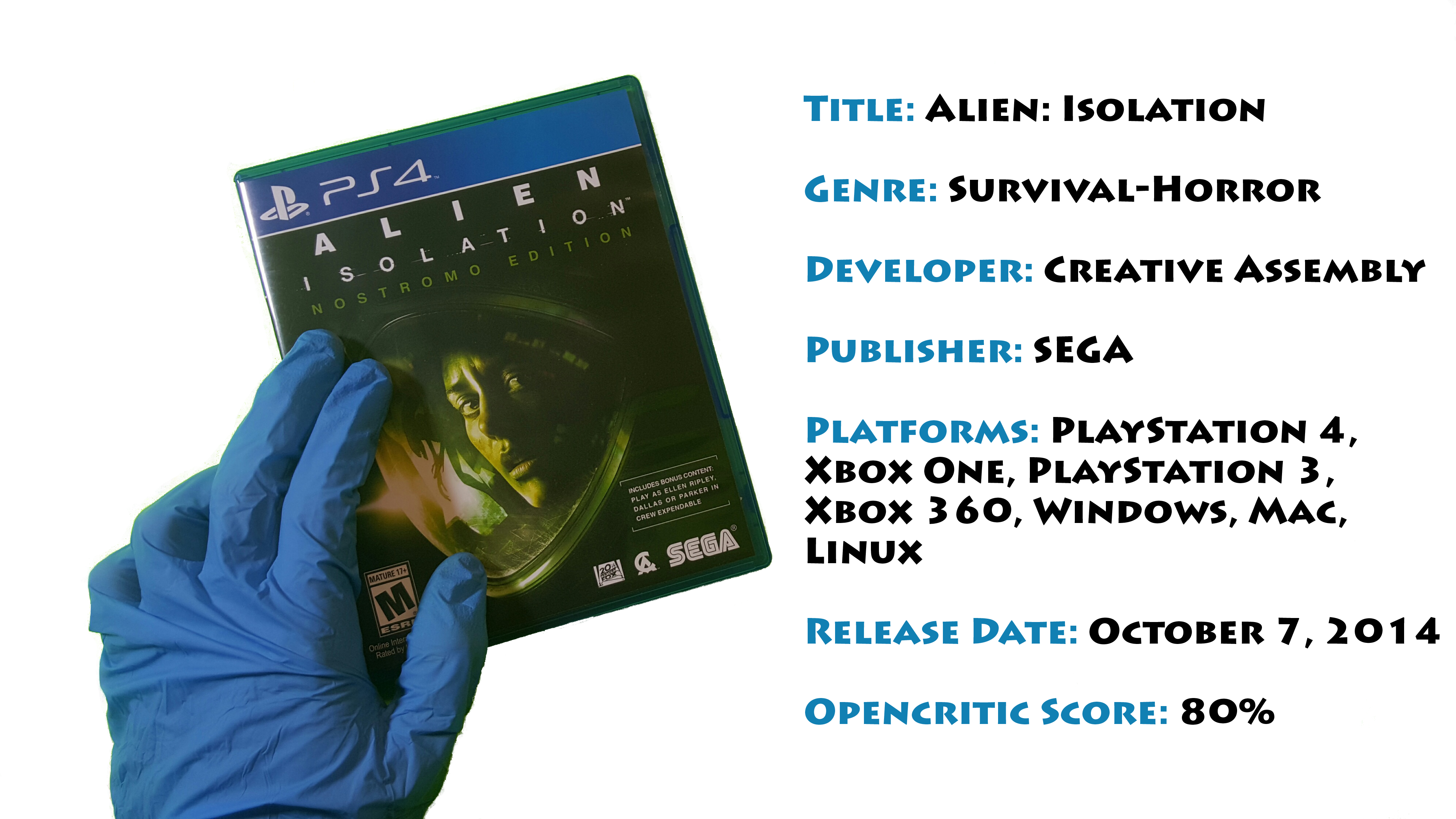
Story
It’s been years since Amanda Ripley has heard from her mother. What she does know is that something catastrophic happened to the Nostromo space station when Ellen was aboard, but with Weyland-Yutani officials trying to cover it up and Amanda being somewhat helpless in her position, the only thing she could do was wait. Having taken up engineering as a career over the long years, she finally hears word from a Weyland-Yutani synthetic named Samuels that another space station, Sevestopol, had apparently recovered the black box from the Nostromo. What could this lead to? Could her mother still be alive somewhere? While hesitant to accept Samuel’s offer to join his small crew at first, she accepts and boards a spaceship headed straight for Sevestopol Station. It couldn’t be passed up. She would have answers and her search would end or, perhaps, lead to some sort of closure.
When Amanda and the crew attempt to make contact with Sevestopol, there’s no response, which means they have to board it the hard way by donning spacesuits and drifting toward an airlock. Halfway there, an explosion rips from the station and sends debris flying their way, severing their harnesses and sending each of them in different directions. Amanda manages to find a handhold to make it inside, but what’s happened to her teammates? Why does Sevestopol look like a tornado went through it and swept everyone away? One misfortune after another follows and gives her more answers than she would like, but she’s a survivor. A Ripley. Like mother, like daughter.
The plot structure faintly reminds me of Aliens with a similar tone and setting to Alien. Amanda largely must work on her own and trust no one, making her way across Sevestopol to figure out not only how to get off of it, but also how to deal with the Xenomorph she encounters as it slowly eliminates everyone. It’s the cause of all this chaos and mistrust among everyone, and creepy synthetics that are killing everyone in sight don’t help matters either. Either way, it’s incredible to see Amanda take it all on while playing as her. After watching the Director’s Cut of Aliens, I wondered what she did for all those years while her mother was in cryosleep. It’s a lovely time period to address, and seeing how Amanda exhibits her mother’s brashness, ability to take charge, cleverness, and strong will to survive is awesome. However, it’s unfortunate there isn’t much character development for her or anyone else. Characters are means to ends, moving the plot along to make something go wrong later, help you get to a new area, being chowder for the Xenomorph, and so forth.

Amanda’s lack of characterization may leave you wanting more, but hopefully Creative Assembly will capitalize on the impact this traumatic journey has had on her next time.
Amanda suffers from this because she’s largely defined by what you do rather than how she expresses herself. What I mean is that much of her dialogue consists of monologues on what she needs to do next and witty lines commenting on her ever-worsening circumstances. There were great cutscenes near the beginning that started to provide a great picture of her, but they strangely become nonexistent halfway through the game. I hoped to be acquainted with what made her special compared to Ellen, her history with and affection for her mother, and how her emotionally motivated quest to find closure might clash with putting her own safety or others’ needs above that lifelong goal. Covering only these topics would have defined her a lot, but instead the story’s held together loosely by character relationships and development. What keep the story going are never-ending streams of fetch quests to repair this thing, get that part, manually turn on some emergency power, or what have you to get off this space station cursed by Murphy’s Law. To put it another way, while I enjoyed the frame of her character, Creative Assembly should’ve focused more on painting inside it rather than worrying more about what’s around it. One of the game’s most pivotal scenes carries weight on its own, but how Amanda reacts to it is brief and brushed under the rug so more urgent matters are addressed; there aren’t enough quiet moments of introspection or socialization with what allies Amanda has for the player to become invested in her and others.She’s a woman on a mission and there’s no time for talk. Yes, I’m aware “Isolation” is in the title, but that’s no excuse for having a solid base for characterization and not building a cast of pillars upon it that uplifts the story to greater heights.
However, there’s something extraordinary Creative Assembly accomplished on the flip side. Sevestopol Station is one of the greatest characters, and that’s no joke. After hours of examining graffiti on the walls, how people have been killed, and Archive Logs that capture the dilapidated and corrupt state of the station and its passengers, you get a well-rounded sense of what life was like here leading up to the tipping point when everything went to hell. The situation was bound to blow up on Sevestopol as you discover more about its tarnished history and reputation, so the Xenomorph only accelerated and exacerbated its downfall. Being able to have a thick understanding of that process through extraneous lore and seemingly filler objects and art is quite the achievement, because how often does the environment have more personality than the actual characters?
Taken as a whole, the story’s more about the moment-by-moment objectives to keep things going than the characters, and I must say that while this plot structure is undesirable here, it was never so boring that I became disinterested, especially since there are a lot of intriguing connections made to important elements in the larger Alien universe. The narrative gets the job done of keeping the player’s interest to see how Amanda will get out of each situation, but it’s still disappointing how the writers couldn’t take more pages from the first film’s compelling drama between its cast and how that type of conflict is part of what makes it engaging.
Gameplay
To put it simply, Isolation is a more robust version of Outlast. As is the case with survival-horror games, Amanda (who you control from a first-person perspective) is limited in her options to fight, but acquires various weapons and equipment (such as a pistol, smoke grenades, Molotov cocktails, etc) that can distract, hinder, or kill humans and synthetics. Doing this is no easy task though since it consumes what precious supplies and ammo you own, so resorting to sneaking past foes is the way to play, which is why you’ll be using your handy-dandy motion tracker a lot not just on them, but the Xenomorph as well. It’s impossible to kill and can only be temporarily stopped with fire, so it alone encourages a cautious playstyle. Besides, you’d likely need to restart the game if you killed everything in sight; you’re punished for being reckless by not leaning to check around corners, bringing up your beeping tracker when the Xenomorph isn’t around, and making noise by running or knocking objects over. You’re supposed to focus on hiding in lockers or under beds to avoid contact and worry about collecting ammo and parts as you sneak around, which can help you craft all the secondary items you’ll be using to get out of sticky situations. It reminds me of The Last of Us’ mechanic in that you craft in realtime and have to have a certain number of things to be able to construct particular equipment. Other than that, you’ll get contextual items that allow you to access new areas you’ll be backtracking through and be able to use environments to your advantage at times by setting off alarms and what have you. That’s a general overview of what the gameplay’s like, and I’d say it’s definitely great.
An awesome balance is struck by making Amanda highly vulnerable yet formidable in self-defense. While I was surprised by how full my arsenal of items always was starting from the campaign’s halfway point (which made me feel more safe than I should’ve felt) on the hardest difficulty, I still think you’re not pampered or punished too much. I tend to play very conservatively anyway and still struggled with acquiring some items, having no choice but to avoid the alien with no means of fending it off on occasion. And that’s how it should be! I love the desperation and tension that come from those dire straits because they define survival-horror. It’s not so much about how scary monsters are, but how they generate those feelings by making it complicated to avoid or fight them. You see, I personally find the Xenomorph not that frightening, but when it’s close by sniffing me out, running after me from an unknown direction, or crawling through the air ducts, that never fails to keep me on edge. Why, I distinctly remember approaching this door I had labored to unlock while trying not to attract the alien’s attention. In the process of getting it open though, the Xenomorph decided it was a good time to drop out of the air duct right behind me. I inhaled sharply and prayed I would get inside in time, but it was too late. That familiar shriek reverberated through the empty room and I heard the pounding of its feet headed toward me. However, I managed to get a split second to swing around and unleash a blast of fire towards my nemesis as I jumped seeing how close it had gotten. It may have bumped into me, but it cowered and fled off into the distance. You bet I let out a “woot” after that!
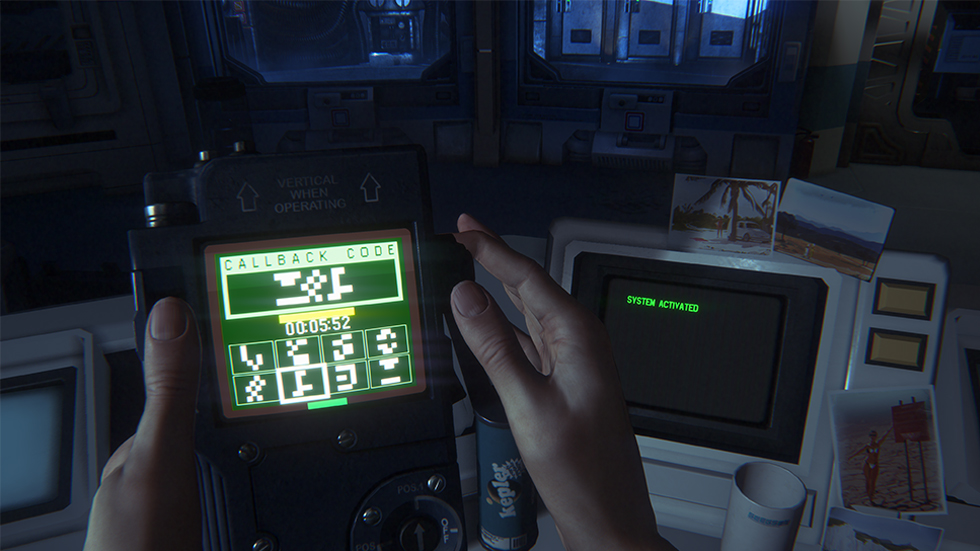
The Security Access Tuner is simple. You need to punch in the symbols on the top display from right to left. No, it being simple doesn’t make it any less stressful to do rapidly under duress!
Speaking of the Xenomorph, it’s remarkable what programming must’ve went into making its behavior and movement seem natural. Depending on what and how much noise you make in an area, it will stay in that location for a certain amount of time and can actually discover you when you’re well hidden. Other times you might be crouching behind a counter and see it towering over you from mere yards away, but it won’t notice you. Half of the time the Xenomorph is unpredictable since it hones in on where you are by dragging you through an air duct if you’re sprinting or even just walking through a hallway. It can cut you off from routes of escape, immediately drop back down in the same area it just left, and so on. Outlast lacks this kind of AI since enemy patterns are easy to get the hang of, but Isolation doesn’t fall into this trap. With only one enemy to work with, I was left impressed that the Xenomorph was able to surprise me when I least expected it, even if its perception became rightfully frustrating sometimes. Design director Gary Napper says it’s “an AI entity that works under its own logic, hunting for signs of the player, other humans on board, and anything it can kill. It adapts to the player’s movement, choices, weapons, and makes some interesting design possible.” He’s right. It’s an AI foe that eliminates probabilities through a process of elimination to find you. Tell me that isn’t cool.
However, I will say that the radial menu you access to equip and craft items is clunky in tight spots. It takes a couple of seconds to assign something specific, and those seconds are precious when any threat is around. While you can cycle through a couple items more quickly with the d-pad, you never know quite sure what you’ll need on the fly, so this is a slight nuisance to work with when things get serious. Another major issue people have with Isolation is the backtracking, which you’ll be doing given the nature of how you’re going there and back again often to repair something or snatch this part, but I think the negativity is an overreaction. I never felt like I was returning to the same areas too many times since doing this is evenly spread out over exploring fresh parts of Sevestopol. In truth, I felt it suited the game and made me better understand the vast size of the ship to feel more attuned to the station’s general layout. In addition, loads of complaints are leveled at how you save, which is essentially a lighter version of Resident Evil’s ink ribbon saving mechanic. Instead of a consumable item, Amanda has a keycard she inserts into a terminal to log her progress, and there are no checkpoints between these points. What makes it scary is when you find one of them, you must wait about four seconds as you insert and sync your keycard before you can actually save, so you best hope that you don’t have anyone on your tail or you’re done for.
Again, this is a griping point since this design has been described as annoying and painful to deal with. However, since I encountered a terminal every five to 10 minutes and — if memory serves me right — never died in front of one, this is something I refuse to accept as legitimate criticism. You can simply not like it, but to call this save mechanic as cruel and unusual punishment seems like a lie to me when I think it should actually take slightly longer to save and, perhaps, that the Xenomorph should be more aware when you’re near these spots. I can see why people would say Amanda doing this in-game doesn’t make much sense (e.g. it isn’t as logical/fitting as the inventory management and health meter in Dead Space), but is using a typewriter to record your progress in Resident Evil any more sensible? It’s a cute, little thing that explains away this saving system in Isolation, which I think goes hand-in-hand with more pure survival-horror titles similar to it. I commend Creative Assembly for going through with this, and you can check out the team’s reasons for doing so in this insightful Gamasutra article. Oh, and I failed to mention the level design is part of what makes the AI fun to outsmart. There are various routes you can take around or straight to your objectives, allowing for perfect opportunities to suddenly divert course when the Xenomorph is around and explore rooms for Archive Logs, blueprints that can unlock better versions of equipment, and safes that have goodies locked behind passcodes. What’s interesting to note about this is that the game’s technically open world since you can backtrack to main areas and ignore objectives, but you’re not encouraged to do so since there aren’t worthy incentives, but at least it puts on an illusion of nonlinearity (it’s highly comparable to Dead Space‘s “open world”).
I may have some issues and other niggling concerns with Isolation’s controls (e.g. spinning around takes to long!) and think the constant, fetch quest objectives become repetitive over time (already mentioned this adversely affects the story), but I still admire the game. It’s risky and daring in today’s game industry, and while it may not succeed in every area, the gameplay doesn’t give in to safe tropes like turning into a mindless shooter. It makes you feel like you’re living out Alien, and that’s something no other game under this licensed property has accomplished to a degree like this.

#squadgoals
Visuals
I mentioned above that Isolation makes you feel like you’re living out the first film, right? That’s in regard to gameplay, and with any other game, I usually say I’ll play one for that or the story. The funny thing is that one of the main reasons you should play this title is for the visuals. Yes, at least half of my love for it originates from my utter fascination with the graphics and art direction! Holy cow. Everything in this game looks it was pulled straight out of the movies! That includes a boatload of original designs and ideas from the developer that conform to a tee with Ridley Scott’s gritty, dated 1979 vision for the future. Everything’s big, unwieldy, clunky, and puts function way over design. Any technology you can think of from the 70’s inspires the architecture of Sevestopol and retro advertisements plastered on walls. The main materials used for tools also look like they were made from cheap plastics and heavy metals, which can be seen in the radar tracker you carry and computers you’ll access. The aesthetics are unreal, and it helps that the lighting, textures, and shockingly dynamic, fluid animations for the Xenomorph are phenomenal. Besides some aliasing issues, a lack of 60 frames-per-second performance on consoles, and passable motion capture work for faces, there’s not much else that could be improved. Seriously, I have never had the pleasure of witnessing a piece of media that could be more faithful to its source material than this. Isolation goes beyond that and, dare I say, improves on what Ridley Scott started by bringing new elements into his universe that make its technology not only more visually striking, but also seem just as dangerous and unreliable as it seems in the movies. It’s a tour de force for your eyeballs that’s arguably the most immersive and jaw-dropping aspect of the game.
Audio
The same could almost be said for the music and sound effects, which equally emulate what the films established, particularly the first one. I’m always surprised by how atmospheric it is compared to the sequel since there are so many scenes that linger on corridors and rooms around the Nostromo. It’s a clever tactic to not only familiarize the audience with what this station looks like, but also how it sounds in the absence of activity. Because of this filmmaking there never seems to be a comfortable volume of audio, which Isolation copies. You’ll hear the squeak of your sneakers across a polished marble floor, the faint clatter of a soda can tipping over on a table, and the humming of electronics as you walk by machinery. There’s noise for everything that Amanda can bump into or walk past that seems uncomfortably louder than usual since everything else is eerily quiet, which is why the sudden blaring of an alarm or shot fired from a pistol is effective in affecting your emotional state and immediate reactions to what’s going on. It was pivotal that the developer nail this unpredictable flux and contrast between silence and loudness so the player seems to never find respite, which is what its team did since merely walking around or slamming a locker feels scarier than it should given the overall silence that permeates Sevestopol. When you violate this atmosphere, it feels like invisible eyes are turned on you. It’s tense as heck.
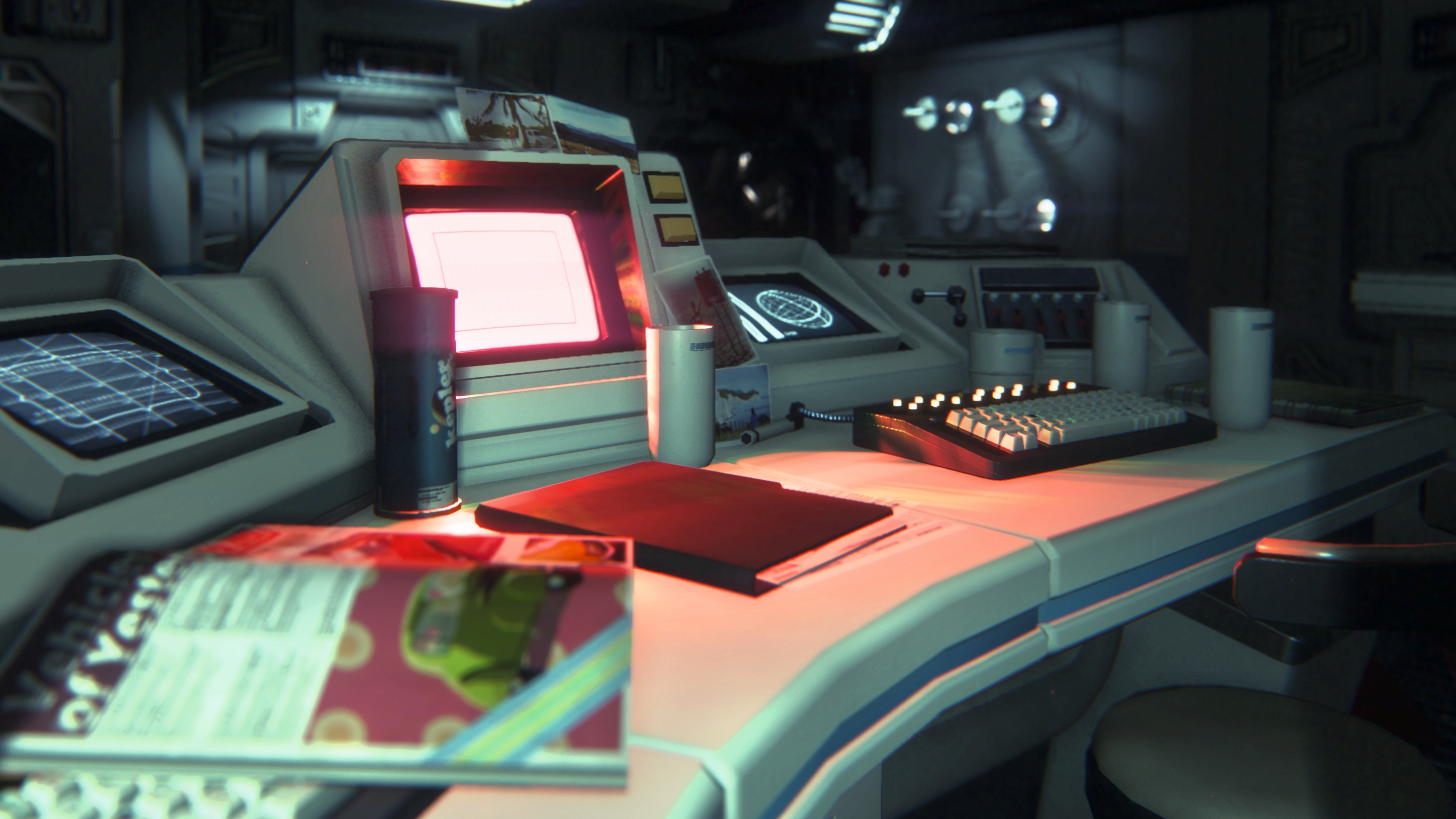
One out of thousands of screenshots that could encapsulate how well Isolation maintains its retro style. Nothing looks out of place, even the way that calendar or cup looks.
The voice acting works. I wouldn’t say there are particular characters of note besides Amanda that delivered a memorable performance (the original cast from Alien recorded some lines for the game though!), but yes, Andrea Deck does a fine job of conveying stress and panic to sell Amanda’s fear. What’s more important to address is the music composed by Joe Henson and Alexis Smith, which is…again, it’s just like the first movie! The subtle, dissonant orchestra, brief moments of beauty drowned out by chaotic percussion and screeching strings, the iconic “whale” sound and tons of atmospheric sounds, and more put you on edge. And since the music is designed to be emergent, it can switch tones in an instant depending on what’s happening. A moment of hope marked by a quick round of strings playing staccato notes or the fear of being caught accompanied by a high-tempo heartbeat-esque drums: it’s all here to better immerse you in the Alien universe. At this point it’s no wonder why the discerning Sigourney Weaver gave this game her stamp of approval. Not to mention the audio got a BAFTA, too.
Value
With a 20-hour long campaign, Isolation isn’t a throwaway campaign. It’s the heart and soul of the package, which is blatantly obvious given the meticulous detail and loving care that went into making it. I will confess that this substantial length could have been cut another three or five hours since some sections of the game drag on too long, but I personally didn’t mind them since I adore being absorbed in the Alien universe. Other than that, one thing I can’t wait to delve into at a later date is the Survivor mode. It consists of maps specifically designed to push you to the extreme with less equipment and practically no weapons, more Xenomorphs to deal with, fewer places to hide, etc. I tried it for a little bit and couldn’t believe how hard some of these challenges are, and with multiple DLC map packs available for purchase that are generally worth the price tag (including some where you play on the Nostromo as classic characters like Ellen!), this is a great distraction on the side if you’re looking for more content after the credits roll.
Verdict
Alien: Isolation is an exercise in patience and restraint as an authentic survival-horror adventure. Whether you act upon fight or flight, the restrictions imposed on the moment-to-moment gameplay never fail to make sneaking or making a scene filled with excitable tension. While some design choices, a lack of diverse objectives, minor issues with the controls, and passable characters will contribute to varying bouts of boredom, it’s more than worth to see Amanda through to aurally and visually absorb every second of the distinct retro-futurism that Creative Assembly perfectly replicates and improves upon. As an Alien or survival-horror fan, it might as well be “game over” if you don’t choose to join up for this mission to go against the perfect organism.
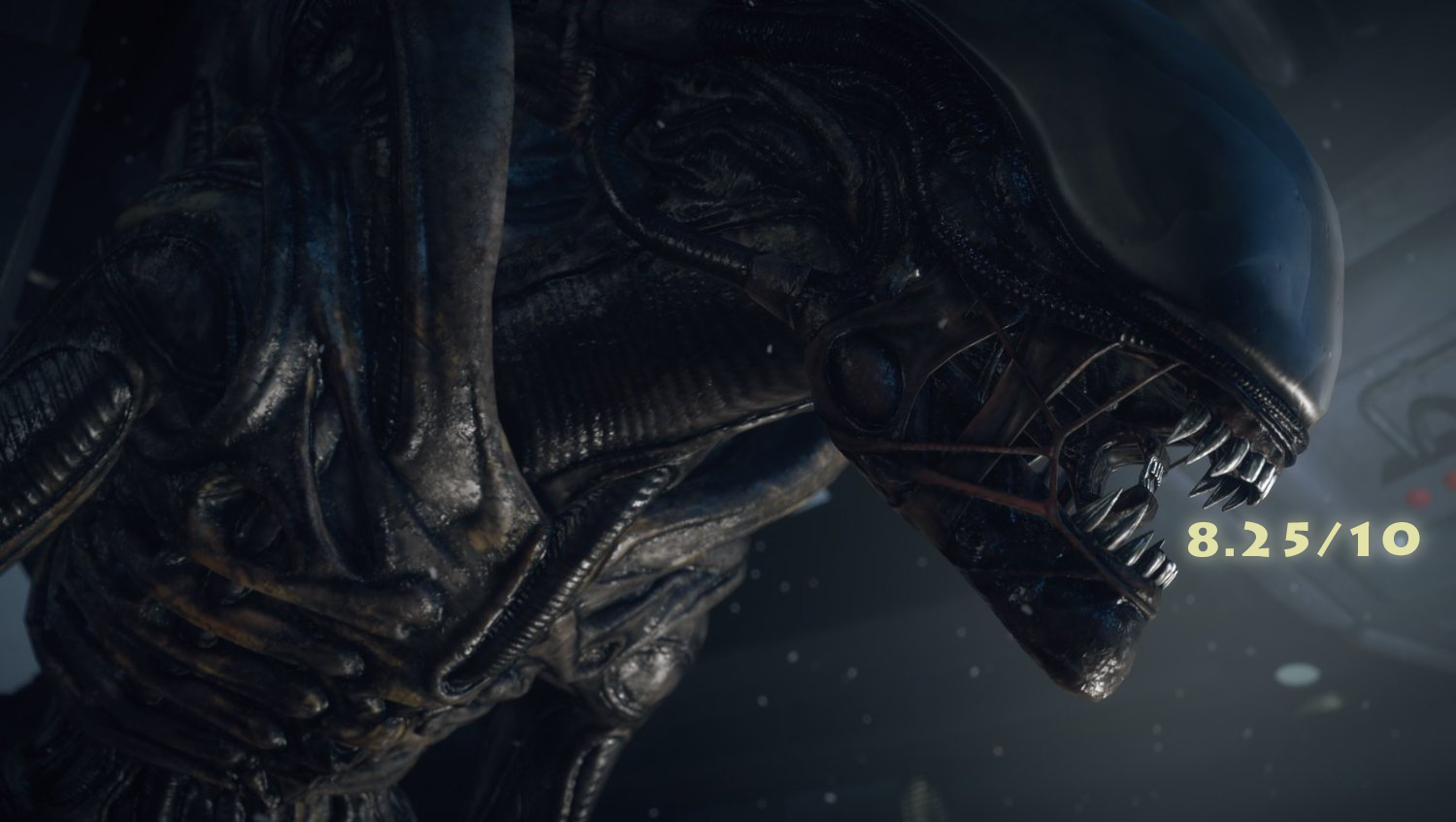
The pictures are taken directly from press content provided by Creative Assembly to show off Alien: Isolation and were made by the developer, with the exception of some edits I did.


